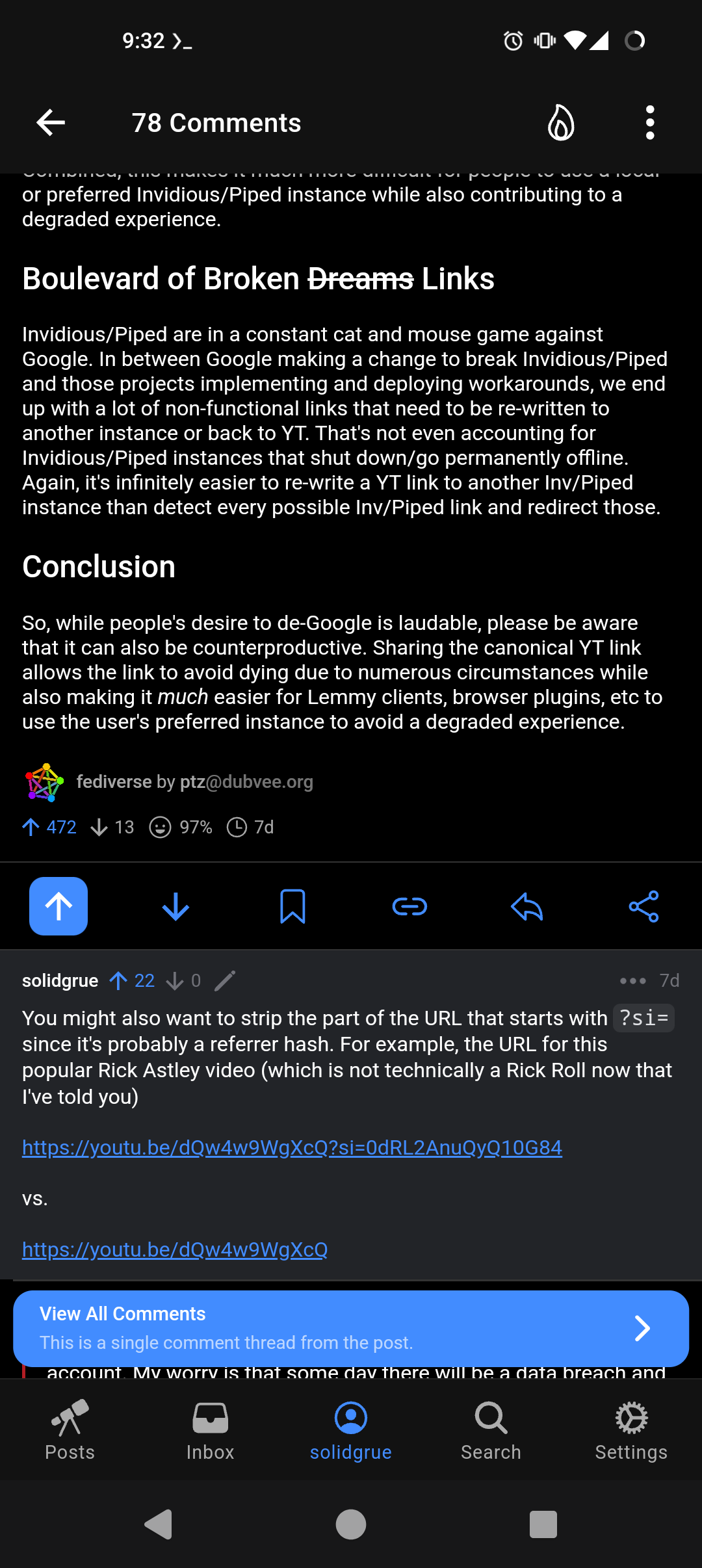SolidGrue
I’m just this guy, you know?
- 17 Posts
- 412 Comments

 103·2 months ago
103·2 months agodeleted by creator

 9·5 months ago
9·5 months agoI read this post using the Alexandrite front end on my laptop browser, then I opened Voyager app on my phone and it shows the post as already having been read.

 1·5 months ago
1·5 months agodeleted by creator

 161·2 months ago
161·2 months agodeleted by creator

 6·5 months ago
6·5 months agoAnd we all get a share!

 3·5 months ago
3·5 months agoI don’t use my computers for modern gaming. Like OP, I prefer tabletop games, though I do speed run crossword puzzles and play some PixelDungeon on my phone when I have spare time. I also built a Retropie, and play some old Atari and PS2 roms on a bored Sunday. My stuff can run Civ IV, which is probably the last title I bought.
My main systems are for work, or for supporting self-hosted services including local infrastructure, home lab stuff, email, blogs, home automation, media servers, etc, etc. Lately I’ve been getting into SDR projects using RPi or old laptops.
So, uh… Yeah. Fun stuff, but not so much gaming.

 22·6 months ago
22·6 months agoYou might also want to strip the part of the URL that starts with
?si=since it’s probably a referrer hash. For example, the URL for this popular Rick Astley video (which is not technically a Rick Roll now that I’ve told you)vs.
(Edit: for the record…

)

 32·7 months ago
32·7 months agoUsually .world upgrades late in the cycle because they’re big, and also in part because they have an outsized impact on federation issues if any should arise in the upgrade.
Also many similar reasons, but mostly because its prudent for .world to wait
+1. Honestly, any of the three can be a recipe for disaster, especially when messing with DVW.
Of all of them, gas is the one that can be explosive, although crossing electrical pairs is a big risk too. I bought my house from an electrician, and you probably would not be amazed at the number of 20A breakers on 14awg branches. There were at least 3 I’ve swapped back to 15A first time I cracked open my panel.
To every man his domain, I say. Myself, I grok electric and plumbing. I hate messing with gas.

 1003·7 months ago
1003·7 months agoWikipedia, kernel sources and some LLM models

 2·7 months ago
2·7 months agoLol, yeah I did but now I’m definitely leaving it

 8·7 months ago
8·7 months agoI wonder how regolith might work out as shielding, as proposed in some popular sci-fi series. Its added mass, to be sure, but regolith plus infernal pressure vessels is probably a good trade-off for the mechanical complexity and added mass.

 9·7 months ago
9·7 months agoUSA. 4 lines with unlimited calls, text, and data. International calling and roaming throughout US, Canada & Mexico. Metered by the mjnute/megabyte for international (off-continent) travel. All in, $200 monthly.
(TMO, magenta plan which is now defunct)
Congratulations!
I’ve had my place 20 years. Here’s a couple of tips:
If you’re not already in a fixed rate loan, refi into one as soon as its feasible for you.
The Home Depot 1-2-3 series books will save you thousands in basic troubleshooting and repairs. YouTube is really good for general handyman advice too. Caveat: learn your limits and don’t take on anything you don’t know ypu can see through. Several hours’ research is generally all you need.
Be judicious about home warranties. They’ll spam you with FUD. Just hang out at a local trades bar and chat with the regulars. You’ll learn a lot.
Electric and water generally* pretty are easy. Don’t mess with the gas lines.
If you DO undertake your own repairs, don’t cut corners and leave it for the Next Guy. That Next Guys will inevitably be you.
Nothing will be plumb, square or true. You learn to deal with it.
If you like to use rich colors in your décor, learn about tinted primers, especially when dealing with red paints.
Equity is Capital. Don’t touch it except for capital improvements to the structures & grounds, and even then be judicious. I’m talking new roof, new sump, kitchens & baths. Do not usenit to pay off consumer debt or college loans. No matter how tempting.
Really, Don’t Touch The Capital.
Live there for you. Its your house. Make it your personal retreat from the world, and set it up how you like it. Don’t worry about resale until it’s actually time to sell.
Again, congratulations and good luck!
–
* for basic repairs, receptacle replacement, and the odd new branch. Know your limits.

 18·8 months ago
18·8 months agoIt’s not DiGiorono, it’s Dispensary!
– stolen from Charlie Berens

 8·8 months ago
8·8 months agoMan, I got stuff to do. Lol.

 74·8 months ago
74·8 months agoI mean…
Steam? Maybe? I dunno, I don’t game but the Steam kids seem to prefer Arch. I’m sure they have their reasons.
Practically? Probably nothing terribly significant.







Yeah, I know.
Aurora is immutable, I fucked up. Oops.
Edit: unsubscribed. My life will be better.